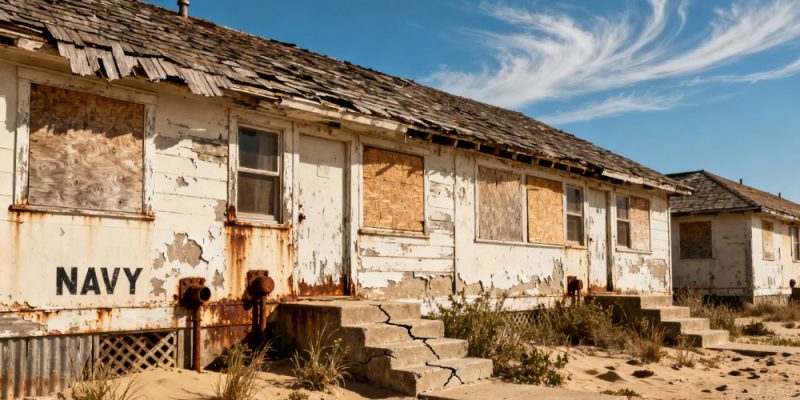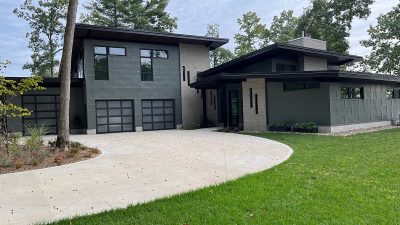Prevalence of Asbestos in Older Construction Materials
Many older Navy housing structures, particularly those built before the 1980s, were constructed using materials that contained asbestos. This was common practice because asbestos was valued for its fire-resistant and insulating properties. Think about it – builders back then were looking for ways to make buildings safer and more durable, and asbestos seemed like a good solution. Unfortunately, we now know the serious health risks associated with it. These materials were used everywhere, from the walls and ceilings to the floors and pipes.
The Role of Insulation and Fireproofing
Asbestos was a go-to additive for insulation and fireproofing products. It was mixed into things like:
- Boiler insulation
- Pipe wrap
- Spray-on fireproofing for structural beams
- Acoustic ceiling tiles
- Textured paints and coatings
These materials were designed to protect the housing from heat and fire, but they also created a hidden hazard. When these materials are intact, the asbestos fibers are generally bound up and not easily released into the air. The problem arises when they start to break down.
Deterioration and Airborne Fiber Release
Over time, asbestos-containing materials can deteriorate due to age, wear and tear, or damage. Activities like renovations, repairs, or even just regular maintenance can disturb these materials, causing microscopic asbestos fibers to become airborne. Once these fibers are released into the air, they can be inhaled. This is where the risk of exposure significantly increases for residents. The longer these fibers stay in the air and the more they are inhaled, the greater the potential health consequences, including the development of serious diseases like mesothelioma.
Understanding Mesothelioma from Navy Housing
The Link Between Asbestos and Mesothelioma
Mesothelioma is a serious disease, and its connection to asbestos is well-established. For decades, asbestos was a go-to material in construction, especially in military housing, because it’s fire-resistant and a good insulator. However, when these materials break down, tiny asbestos fibers can become airborne. If inhaled, these fibers can lodge in the lining of the lungs, abdomen, or heart. Over a long period, this irritation can lead to the development of mesothelioma. The primary cause of mesothelioma is exposure to asbestos fibers.
Latency Period of Mesothelioma Development
One of the most challenging aspects of mesothelioma is its long latency period. This means that even after someone has been exposed to asbestos, it can take many years, often 20 to 50 years or even longer, for symptoms to appear and for the disease to be diagnosed. This extended timeframe makes it difficult to pinpoint the exact source of exposure, especially for individuals who have lived in multiple locations throughout their lives, including various Navy housing assignments. The slow progression means that damage can be occurring silently for decades.
Identifying Mesothelioma from Navy Housing Exposure
Pinpointing mesothelioma specifically to Navy housing exposure requires careful consideration of a person’s history. Key factors include:
- Duration of Residency: How long did the individual live in the specific Navy housing? Longer stays increase the potential for exposure.
- Condition of Housing: Was the housing older, potentially containing deteriorating asbestos-containing materials? Were there any known renovations or disturbances that could have released fibers?
- Occupational History: While this section focuses on housing, it’s important to remember if the individual also had an occupational exposure to asbestos through their Navy service.
- Medical History: A thorough review of medical records and a detailed personal history are vital. Doctors will look for signs and symptoms consistent with mesothelioma and correlate them with potential exposure timelines. Diagnosing mesothelioma often involves imaging tests like CT scans and MRIs, as well as biopsies.
Factors Contributing to Mesothelioma Risk
Duration and Intensity of Exposure
The amount of time a person spent in an environment with asbestos and how much asbestos they were exposed to are big factors in mesothelioma risk. It’s not just about being around asbestos once; it’s often about repeated or prolonged contact. Think about it like this: the longer you’re breathing in those tiny fibers, and the more concentrated those fibers are in the air, the higher the chance they can cause damage over time. This cumulative effect is a primary driver of asbestos-related diseases.
Proximity to Disturbed Asbestos Materials
Where you were in relation to asbestos-containing materials when they were disturbed matters a lot. If asbestos materials were being cut, sanded, or broken up, the fibers become airborne and can travel. Living or working very close to these activities, especially without proper protection, means a much higher dose of inhaled fibers. Even if you weren’t directly working with the asbestos, being in the same vicinity during renovation or demolition projects significantly increases exposure.
Individual Susceptibility Factors
While exposure is key, not everyone exposed to asbestos develops mesothelioma. Some people seem to be more vulnerable than others. This can be due to a few things:
- Genetics: Some individuals may have genetic predispositions that make their cells more likely to react negatively to asbestos exposure.
- Overall Health: A person’s general health status, including their immune system’s strength, can play a role in how their body handles or repairs damage from inhaled fibers.
- Smoking Habits: While asbestos is the primary cause of mesothelioma, smoking can act as a co-carcinogen, potentially increasing the risk and severity of asbestos-related lung diseases, though its direct link to mesothelioma itself is less clear than with lung cancer.
Preventative Measures for Navy Housing Residents
Living in Navy housing, especially older structures, means being aware of potential asbestos risks. While it might seem daunting, taking proactive steps can significantly reduce exposure. Understanding and addressing these risks is key to protecting your family’s health.
Recognizing Potential Asbestos Hazards
Many older homes, including some Navy housing built before the 1980s, contain asbestos in various building materials. It was widely used for its heat resistance and durability. Common places to find it include:
- Insulation: Around pipes, boilers, and in attic spaces.
- Flooring: Vinyl tiles and the adhesive used to lay them.
- Ceiling tiles: Especially in older acoustic ceiling systems.
- Textured paints and coatings: Often found on walls and ceilings.
- Roofing and siding materials: Shingles and cement.
It’s important to remember that asbestos-containing materials (ACMs) are generally safe if left undisturbed. The danger arises when they are damaged, deteriorating, or disturbed during renovations or repairs, releasing airborne fibers.
Minimizing Disturbance of Suspect Materials
If you suspect asbestos is present in your home, the best course of action is to avoid disturbing it. This means:
- Refrain from DIY repairs: Avoid sanding, drilling, scraping, or cutting materials that might contain asbestos. This is especially true for any home improvement projects.
- Handle with care: If you need to clean or maintain areas with suspect materials, do so gently. Avoid vacuuming dust from these areas with a regular vacuum cleaner, as it can spread fibers. Use a damp cloth for cleaning surfaces.
- Secure the area: If materials are visibly damaged, try to limit access to the area until it can be properly assessed and addressed.
Importance of Professional Assessment and Abatement
When dealing with potential asbestos, professional help is not just recommended; it’s often necessary. Trying to manage asbestos yourself can lead to dangerous exposure for you and your family.
- Professional Inspection: Certified asbestos inspectors can identify ACMs through visual inspection and laboratory testing. They know where to look and how to sample materials safely.
- Safe Removal (Abatement): If asbestos is found and poses a risk, licensed asbestos abatement professionals should be hired. They have the training, equipment, and procedures to remove or encapsulate asbestos materials safely, preventing fiber release into the living environment.
- Documentation: Always request documentation from inspectors and abatement contractors. This includes their certifications, the scope of work, and clearance testing results after the work is completed, confirming the area is safe.
Health Monitoring and Early Detection
For individuals residing in or having previously lived in Navy housing, particularly older structures, regular health monitoring is a sensible step. Given the potential for past asbestos exposure, being aware of what to look for and when to seek medical advice can make a significant difference. Early detection is key when it comes to conditions like mesothelioma.
Regular Medical Check-ups for At-Risk Individuals
It’s wise for those with a history of potential asbestos exposure, especially in older Navy housing, to schedule routine medical check-ups. These appointments provide an opportunity for open discussion with a healthcare provider about any concerns. Doctors can then tailor screenings or examinations based on individual risk factors. This proactive approach helps in catching any developing issues early on. Consider discussing your housing history with your doctor; they can help you understand your specific risks related to asbestos exposure.
Symptoms Warranting Immediate Medical Attention
While mesothelioma often has a long latency period, certain symptoms should prompt prompt medical evaluation. These can include:
- Persistent cough that doesn’t improve
- Shortness of breath, even with minimal exertion
- Chest pain, particularly when breathing deeply
- Unexplained weight loss
- Fatigue or weakness
It’s important to note that these symptoms can be indicative of various conditions, but if you have a history of potential asbestos exposure, they should not be ignored.
Diagnostic Tools for Mesothelioma Detection
When symptoms raise concerns, medical professionals have several tools to investigate further. These diagnostic methods help in identifying or ruling out mesothelioma:
- Imaging Tests: Chest X-rays and CT scans can reveal abnormalities in the lungs and chest cavity.
- Biopsy: A tissue sample is taken from the affected area for microscopic examination. This is often the definitive way to diagnose mesothelioma.
- Blood Tests: While not diagnostic on their own, certain blood markers may be monitored.
These tests, combined with a thorough medical history, allow for a more accurate assessment of an individual’s health status.
Naval Community Awareness and Support
Educating Families About Asbestos Risks
It’s important for everyone living in older Navy housing to know about the potential dangers of asbestos. Many families might not realize that materials used in construction decades ago could still pose a health risk. Open communication and education are key to protecting your loved ones. Understanding how asbestos fibers can become airborne, especially during renovations or if materials are damaged, helps residents take necessary precautions. This awareness extends to recognizing the signs of potential asbestos-containing materials and knowing when to seek professional advice. Learning about the history of asbestos use in building materials can provide context for why these risks exist in certain housing structures.
Resources for Affected Navy Personnel and Families
Families dealing with potential asbestos exposure or a mesothelioma diagnosis need access to reliable support. Fortunately, there are organizations dedicated to helping. For instance, military families facing treatment for serious illnesses can find temporary lodging through programs like the Fisher House Foundation, which provides homes near military medical centers. This can ease the burden of travel and accommodation during difficult times. Knowing where to turn for financial aid, legal advice, and emotional support is vital. Many groups offer specific assistance for veterans and their families affected by asbestos-related diseases. You can find more information on support for military families at Fisher House Foundation homes.
Advocacy for Safer Housing Standards
Beyond individual awareness, there’s a broader need to advocate for safer living conditions. This involves pushing for better housing inspection protocols and timely remediation of asbestos hazards in Navy housing. Residents can play a role by reporting concerns and participating in community discussions about housing quality. Pushing for updated building codes and stricter asbestos management plans benefits current and future residents. Collective action can lead to systemic changes that prioritize health and safety. This advocacy helps ensure that housing provided to naval personnel meets modern safety standards, reducing long-term health risks for all who live there.
Reference Materials













Comments